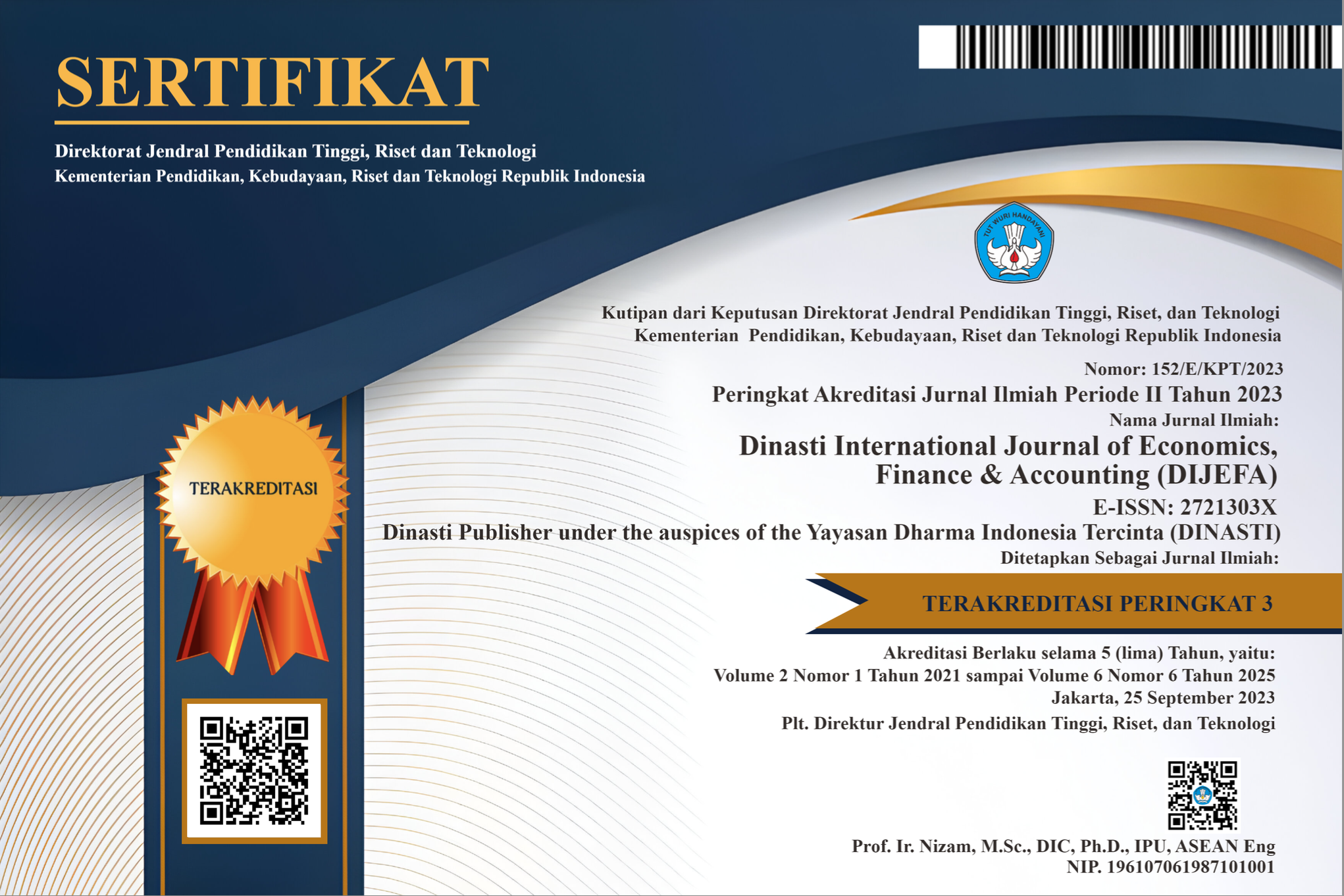Nurturing a Sustainable Harvest Pivoting on Green HRM in Agricultural Productivity and The Environment
DOI:
https://doi.org/10.38035/dijefa.v5i3.2943Keywords:
Green HRM, environmental protection, culture of collaboration, business innovationAbstract
This paper shows the performance of HR collaboration on the environment, in other words, GHRM can increase agricultural productivity while protecting the environment. The method is qualitative with a case study on a farm in Cirebon Regency, West Java, which applies the concept of GHRM. Data were collected through interviews, observations, and document analysis through SWOT Analysis. The findings of GHRM can be achieved through fostering a workforce that cares about the environment, encouraging innovation and collaboration, influencing organisational culture and decision-making, and generating new businesses such as garden/nature tourism, educational tourism, and spiritual tourism. The novelty of the research from the SWOT analysis is that collaborative GHRM leads to new sustainable businesses. Limitations The study was only conducted in Cirebon Regency, West Java—implications of the research directly on stakeholders and government through policies that favour collaboration for sustainable business.
References
Adekoya, O. D., Ajonbadi, H. A., & Mordi, C. (2023). Impact of Green HRM Practices on Employees’ Pro-Environmental Behaviour in the United Kingdom. Dalam Global Perspectives on Green HRM: Highlighting Practices Across the World (hlm. 69–95). Springer.
Ambarwati, A., Wahyuni, D., Dewi, A. J., Kuswara, W., & Setyaningrum, R. P. (2023). Green Human Resources Management in Industrial Companies on Sustainable Business: Conceptual Approach. Jurnal Ekonomi Syariah Pelita Bangsa, 8(02), 292–299.
Bandura, A. (2001). Social Cognitive Theory: An Agentic Perspective. Annual review of psychology, 52(1), 1–26.
Borrego, P. (2022, Desember 11). How Farmers and Ranchers Can Care for the Environment—Goure. Diambil 27 Mei 2024, dari https://goure.eu/how-farmers-and-ranchers-can-care-for-the-environment/
BPS. (2023, Desember). Hasil Pencacahan Lengkap Sensus Pertanian 2023—Tahap I [Badan Pusat Statistik Indonesia]. Diambil 22 Mei 2024, dari https://www.bps.go.id/id/pressrelease/2023/12/04/2050/hasil-pencacahan-lengkap-sensus-pertanian-2023---tahap-i.html
D’Odorico, P., Chiarelli, D. D., Rosa, L., Bini, A., Zilberman, D., & Rulli, M. C. (2020). The global value of water in agriculture. Proceedings of the national academy of sciences, 117(36), 21985–21993.
Elena, T., Natalia, S., Marina, M., & Angelika, V. (2024). Soil Degradation in the Process of Agricultural Activities. BIO Web of Conferences.
Ende, E., Sulaimawan, D., Sastaviana, D., Lestariningsih, M., Rozanna, M., Mario, A., … Marry, F. (2023). Manajemen sumber daya manusia.
Hadi, L., Kuswanto, W., Tarmudi, I., & Mukhlisin, M. (2024). Keanekaragaman Hayati: Merawat Alam, Menjaga Keseimbangan. Indigo Media.
Halder, K. G., Mondal, S., Hossen, M. S., Sarkar, S., & Dawn, A. S. (2023). Enhancing Agricultural Production through Soil Constituent Analysis and Crop-Specific Soil Management. International Journal of Enhanced Research in Science, Technology & Engineering, 12(11).
Jiang, S., Zhou, J., & Qiu, S. (2022). Digital agriculture and urbanization: Mechanism and empirical research. Technological Forecasting and Social Change, 180, 121724.
Kiliç, Z. (2021). Water Pollution: Causes, Negative Effects and Prevention Methods. ?stanbul Sabahattin Zaim Üniversitesi Fen Bilimleri Enstitüsü Dergisi, 3(2), 129–132. https://doi.org/10.47769/izufbed.862679
Klassen, A. C., Creswell, J., Plano Clark, V. L., Smith, K. C., & Meissner, H. I. (2012). Best practices in mixed methods for quality of life research. Quality of life Research, 21, 377–380.
Krisnatalia, H., Prasetyo, N., & Ainan, M. (2023). Pendampingan Kertayasa Sebagai Desa Wisata Edukasi Berbasis Pertanian Organik. Jurnal Pengabdian kepada Masyarakat Nusantara, 4(4), 5200–5206.
Kumari, N., & Kathuria, K. (2022). Conceptual Framework of Green Human Resource Management (GHRM) for Corporate Sustainability. International Journal of Science and Research (IJSR), 7.
Mekonnen, A., Tessema, A., Ganewo, Z., & Haile, A. (2021). Climate change impacts on household food security and farmers adaptation strategies. Journal of Agriculture and Food Research, 6, 100197.
Mohamed, E. S., Belal, A. A., Abd-Elmabod, S. K., El-Shirbeny, M. A., Gad, A., & Zahran, M. B. (2021). Smart farming for improving agricultural management. The Egyptian Journal of Remote Sensing and Space Science, 24(3), 971–981.
Parr, J. F., Papendick, R. I., Youngberg, I. G., & Meyer, R. E. (2020). Sustainable agriculture in the United States. Dalam Sustainable agricultural systems (hlm. 50–67). CRC Press.
Parsono, S., Zakiyuddin, A., & Utami, I. (2021). Penerapan Teknologi Media Tanam Hidroponik untuk Mewujudkan Wisata Pertanian di Desa Cimekar. Jurnal Pengabdian Tri Bhakti, 3(1), 14–22.
Pavlou, P. A., & El Sawy, O. A. (2011). Understanding the Elusive Black Box of Dynamic Capabilities. Decision Sciences, 42(1), 239–273. https://doi.org/10.1111/j.1540-5915.2010.00287.x
Rahman, M. M., Khan, I., Field, D. L., Techato, K., & Alameh, K. (2022). Powering agriculture: Present status, future potential, and challenges of renewable energy applications. Renewable Energy, 188, 731–749.
Rangkuti, F. (2018). Teknik Membedah Kasus Bisnis Analisis SWOT. (24 ed). Jakarta: PT. Gramedia Pustaka Utama.
Ren, S., Tang, G., & E Jackson, S. (2018). Green human resource management research in emergence: A review and future directions. Asia Pacific Journal of Management, 35, 769–803.
Risqi, D. M. (2022). Penegakan Hukum Lingkungan. JHP17 (Jurnal Hasil Penelitian), 6(2), 39–44.
Saha, S., Sarker, R., & Ahmed, S. M. (2020). Impact of Green Human Resource Management (GHRM) practices in garment industry: Bangladesh perspective. International Journal of Management and Accounting, 2(2), 22–30.
Sottomayor, M., & Tranter, R. (2011). Likelihood of Succession and Farmers’ Attitudes towards their Future Behaviour: Evidence from a Survey in Germany, the United Kingdom and Portugal. Int. Jrnl. of Soc. of Agr. & Food, 16(2), 121–133.
Sridhar, A., Balakrishnan, A., Jacob, M. M., Sillanpää, M., & Dayanandan, N. (2023). Global impact of COVID-19 on agriculture: Role of sustainable agriculture and digital farming. Environmental Science and Pollution Research, 30(15), 42509–42525.
Stanley, M. (2023). Environmental Impacts of Agricultural Modifications [National Geographic]. Diambil 19 Mei 2024, dari https://education.nationalgeographic.org/resource/environmental-impacts-agricultural-modifications
Taufiqurrohman, Moch. M., & Jayanti, D. R. (2022). Regulasi Regenerasi Petani dalam Konteks Ketahanan Pangan: Sebuah Upaya dan Jaminan Perlindungan Hak Atas Pangan. Jurnal HAM, 13(1), 29. https://doi.org/10.30641/ham.2022.13.29-44
Teece, D. J., Pisano, G., & Shuen, A. (1997). Dynamic Capabilities and Strategic Management. Strategic Management Journal, 18(7), 509–533. https://doi.org/10.1002/(SICI)1097-0266(199708)18:7<509::AID-SMJ882>3.0.CO;2-Z
Tolinggi, W. K., Salman, D., Rahmadanih, & Iswoyo, H. (2023). Farmer Regeneration and Knowledge Co-Creation in the Sustainability of Coconut Agribusiness in Gorontalo, Indonesia. Open Agriculture, 8(1), 20220162. https://doi.org/10.1515/opag-2022-0162
Tono, T. (2022). Pertanian Berbasis Ramah Lingkungan: Meningkatkan Produktivis Dan Mengurangi Biaya. Al-Iqtishad: Jurnal Ekonomi, 14(1), 51–65.
Tudi, M., Daniel Ruan, H., Wang, L., Lyu, J., Sadler, R., Connell, D., … Phung, D. T. (2021). Agriculture development, pesticide application and its impact on the environment. International journal of environmental research and public health, 18(3), 1112.
Vidiati, C., Lathiafaturahmah, L., Selasi, D., Lesmana, D., & Nauroh, I. (2024). Reflection of Maqoshit Sharia on the Concept of Ancient Agriculture for a Sustainable Green Economy. E3S Web of Conferences, 482, 02001. https://doi.org/10.1051/e3sconf/202448202001
Yadav, S. C. (2024). Water Pollution: The Problems and Solutions. Science Insights, 44(2), 1245–1251. https://doi.org/10.15354/si.24.re905
Zagata, L., & Sutherland, L.-A. (2015). Deconstructing the ‘Young Farmer Problem in Europe’: Towards a Research Agenda. Journal of Rural Studies, 38, 39–51. https://doi.org/10.1016/j.jrurstud.2015.01.003
Zhou, M., Li, J., & Yang, M. (2023). Unlocking green growth challenges: Role of green HRM, green career adaptability, and green career success. Environmental Science and Pollution Research, 30(53), 113835–113845.
Zurnali, C., & Sujanto, A. (2020). Pentingnya green human resource management pada perusahaan di Indonesia. Jurnal Ilmiah Infokam, 16(2).
Downloads
Published
How to Cite
Issue
Section
License
Copyright (c) 2024 Ahmad Munajim, Cory Vidiati, Dini Selasi, Izzwah Nauroh, Fidya Arie

This work is licensed under a Creative Commons Attribution 4.0 International License.
Authors who publish their manuscripts in this journal agree to the following conditions:
- The copyright on each article belongs to the author(s).
- The author acknowledges that the Dinasti International Journal of Economics, Finance & Accounting (DIJEFA) has the right to be the first to publish with a Creative Commons Attribution 4.0 International license (Attribution 4.0 International (CC BY 4.0).
- Authors can submit articles separately, arrange for the non-exclusive distribution of manuscripts that have been published in this journal into other versions (e.g., sent to the author's institutional repository, publication into books, etc.), by acknowledging that the manuscript has been published for the first time in the Dinasti International Journal of Economics, Finance & Accounting (DIJEFA).


























































